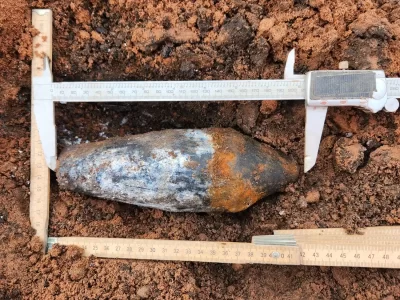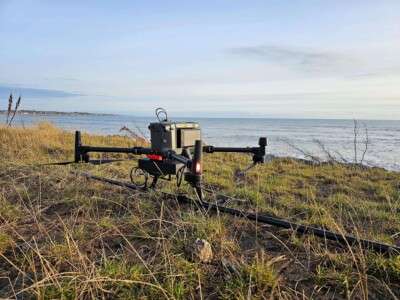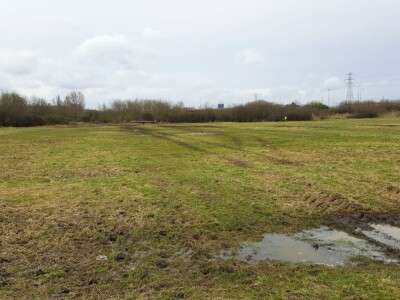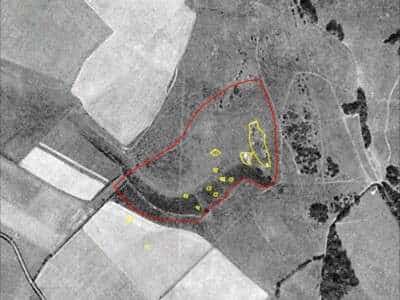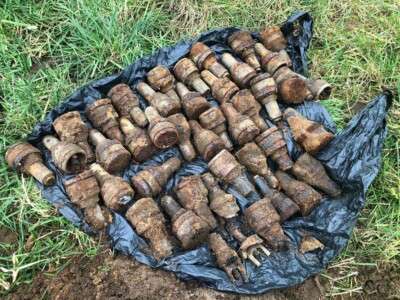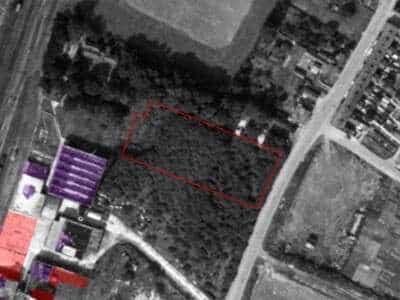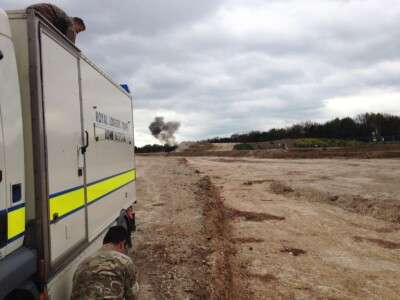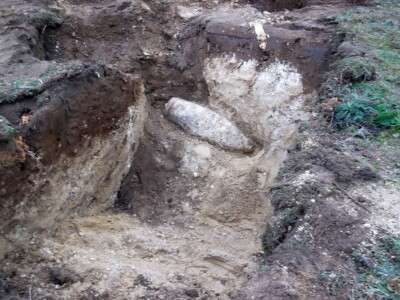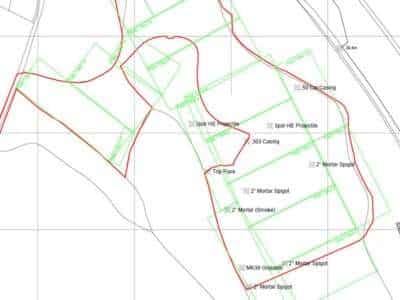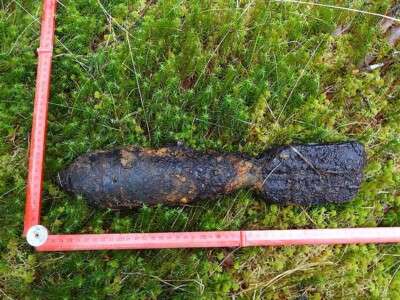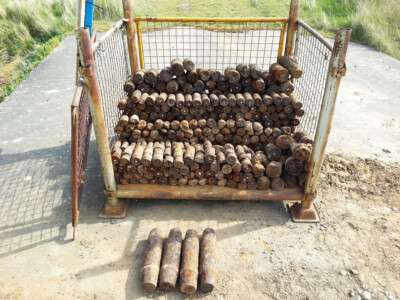Home » Resources » Case Studies »
Case Study Overview
Project End Use
New dock warehouses
Location
Liverpool Docks, Bootle
Industry
Construction
Project Duration
March – October 2023
Services
Detailed UXO Assessment
Intrusive UXO Survey
UXO Support
– Target Investigation
Anomaly Depth
Deepest target found below ground – 9.5m
Plant and Support
Three Survey Rigs and Seven UXO Specialists & Rig Operatives deployed
Survey Area
3.5ha Site Surveyed & Cleared
Challenge
In March 2023, 1st Line Defence were commissioned to undertake a Detailed UXO Risk Assessment for a project in the Liverpool Docks to determine whether any UXO contamination may be present before ground works and any deep piling commenced.
Our client planned to construct some new warehouse facilities, and due to the City of Liverpool (and its Docks) being heavily targeted during WWII, the site needed to be clear of any UXO contamination to allow ground works to proceed safely for all staff working on-site.
Process
Stage 1 – Detailed UXO Risk Assessment
Initial research indicated that at the start of the war, the site comprised a narrow quay between two dock basins, which were almost entirely occupied sheds/warehouses. Liverpool Docks sustained heavy and prolonged attacks during WWII due to its strategic importance to the British war effort.
The vast majority of trade and supplies coming from North America came through the docks, and they were highlighted on numerous Luftwaffe target photographs and maps.
According to various sources, the quay and the area surrounding it sustained numerous bomb strikes. Liverpool bomb tracings highlighted multiple high explosive and incendiary bomb strikes within and adjacent to the site, many of which were corroborated within available written bomb incident records and published sources.
Other points of note included:
- Written reports referenced vessels docked at the quay as being struck and damaged.
- A record was found of a 250kg unexploded bomb (UXB) being removed from an adjacent Grain Elevator structure in June 1941.
- A Dock Estate map confirmed sheds in the western section of the site were damaged.
- Ground level photography indicated that there was severe damage to sheds/warehouses on the quayside.
- Post-war aerial imagery showed sheds in the south-west of the site were cleared during the war.
Due to the level of damage that many of the buildings on the site sustained, and the amount of bombing recorded – it was assessed that there was a significant risk that UXBs could have fallen unnoticed and unrecorded within the site boundary.
UXBs falling into bomb damaged areas were one of the most common reasons for them going undetected during the war. Such areas would generally have been subject to reduced access and checks, and rubble and debris present could easily obscure unexploded bombs (UXBs) entry holes.
Because of the history of the main works area, it was recommended that proactive UXO Support be provided.
Stage 2 – Risk Mitigation Strategy
Because a risk of German unexploded bombs had been identified, and as deep piled foundations were proposed, an Intrusive UXO Survey was recommended to ensure that the piling locations were free from buried German UXBs.
This methodology involves pushing a magnetometer probe into the ground using hydraulic pressure from a specialised rig at the locations of proposed piles, and would provide UXO clearance from the risk of German UXBs in all areas of the site that were being accessed or developed.
If any UXO-related items were discovered, they could be checked, identified and removed safely – and the risk from UXO would be reduced to as low as reasonably practicable (ALARP) before ground works commenced.
Stage 3 – Intrusive UXO Survey
Due to timescales and the size of the site, 1st Line Defence deployed three Intrusive UXO Survey Rigs, and seven UXO Specialists and Rig Operatives were mobilised to site during the operation.
Part way into the survey, a significant ferrous anomaly was detected in the northern extents of the site at between 8.5 and 9.5m below ground level. Additional triangulation surveys were undertaken, and the anomaly was found to be discrete (rather than a buried structure or linear pipe feature). Due to the size and depth of the anomaly, the position could not be considered ‘clear’, and the client was informed. A number of additional similar anomalies were detected ranging between 8.2 and 9.5m depth, all modelling at significant sizes.
Due to the history of the site, the amount of bombing that the area sustained, and the significant depth of the anomalies, the risk of one or more of them being German UXBs could not be discounted. No other reason for their presence could be identified by engineers involved in the project.
We consulted with the client to see if those positions could be adjusted for piling purposes but due to a lack of space available on the project, the client decided to excavate the anomalies. RAMS were adjusted and suitable shafts were created to allow our UXO Specialists to investigate the anomalies – using push and dig methodology. These shafts were essential to the investigation and excavation procedure in order to undertake the investigation safely.
Stage 4 – UXO Support
At the start of September, Target Investigation support was in place whilst excavation works proceeded on the first shaft – which was dug 6m in diameter and supported using reinforced concrete rings.
Later in September, manual excavation of the anomalies began and the first anomaly was reached at the expected depth and perfectly central to the shaft.
A 100m exclusion zone was set up on-site whilst the object was being excavated. After investigation, our UXO Specialists confirmed that the anomaly was not UXO-related. The anomaly was found to be a large iron rod, possible used as part of the dock construction, but deeper than would have been expected from such a remnant.
We continued with the operation and over the next two weeks, our operatives moved from shaft to shaft excavating and investigating each anomaly. All anomalies turned out to be non-UXO related, but due to their particular size and length, and the depth at which they were found, they were indistinguishable from deep buried German UXBs.
The client was able to proceed safely with the piling operation in the knowledge that the risk of encountering UXO in such a heavily bombed area had been reduced to as low as reasonably practicable.
Outcome
Following risk assessments, surveys and ground investigations, the risk from UXO was reduced to ALARP status – and no other suspicious items were discovered during ground works. Through collaboration with the clients on-site teams, the project was undertaken efficiently, and safety of ground operatives maintained.
Latest Case Studies
Do you have a project in Liverpool? Need advice but not sure where to start?
If you need advice about UXO risk mitigation in Liverpool, contact us today and we’ll guide you through the process.
Call: +44 (0) 1992 245020 or Email: info@1stlinedefence.co.uk
Contact Us
* indicates required fields
